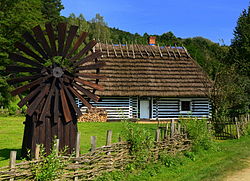Sanok is a historic town in the Polish region of Podkarpackie in Poland. It is in a picturesque location along the San River near foothills and parks, and offers many recreational opportunities.
Understand
[edit]


Once settled by Poles, Jews and Ukrainians, the town's history goes back almost 1000 years when it was part of a medieval trade route. At the beginning of the German occupation during World War II, the Jewish population was around 5,000. During the occupation, most of the Jews were either executed or killed in Nazi death camps or Nazi concentration camps during the Holocaust.
In 2021, it was home to 37,000 people.
Local information
[edit]Sanok Town Council website
Get in
[edit]By train
[edit]Sanok is served by PKP intercity trains, as well as local and regional bus services. The 1 Sanok railway station, is on Dworcowa street a little southeast of the center. There are connections from Rzeszów and Jasło. Some regional trains stop at the 2 Sanok Miasto railway station, which is a little bit closer to the town centre.
By bus
[edit]There are several direct bus connections from Rzeszów and Kraków. As of July 2002, tickets from Rzeszów cost around 17 zł while most tickets from Kraków cost around 55 zł.
By car
[edit]Sanok is linked by various highways to other towns and cities in southeastern Poland. The DK28 road links Sanok with Krosno in the west and Przemyśl in the east.
Get around
[edit]Sanok is compact and many points of interest are easily accessible by foot. Taxis congregate near shops in the central area, and fares tend to be low.
See
[edit]- 1 Open Air Village Museum, Aleksandra Rybickiego 3, ☏ +48 13 463 16 72. An ethnographic museum known throughout Poland. It contains 200 buildings and shows daily life as it was in the 19th and early 20th century.



- 2 Royal Castle. Built in the 14th century on a hill with steep slopes in the town. The castle houses an exhibition of the impressive artwork of Polish artist Zdzisław Beksiński.



- 3 Orthodox Church (Cerkiew Świętej Trójcy), Zamkowa 16.



- Traces of Jewish history, including former synagogues.
Do
[edit]Sanok lends itself to casual exploration. Set out on foot from the Rynek (town square) and explore the sights of this quaint town. In addition, Sanok is close to the Bieszczady Mountains and numerous parks. The region has a 70-km trail for hikers and cyclists.
- STS Sanok. Sanok's best known sports team is its ice hockey club, which plays in the Polish equivalent of the premiership. Matches take place in the new Sanok Arena.
Buy
[edit]You can find most necessities (and more than a few luxuries) in the various shops in the centrum area. Outdoor markets are an excellent source of locally-grown foods.
Eat
[edit]- 1 Karczma Sanok (Karczma Jadło Karpackie), ul. Rynek 12, ☏ +48 13 464 67 00. Traditional and hearty regional cuisine.



- 2 Stary Kredens, plac Św. Michała 4, ☏ +48 797 317 279.



- 3 Dworek Sanocki, ul. 2 Pułku Strzelców Podhalańskich 30, ☏ +48 13 424 11 44.



- 4 Karczma Karpackie Jadło, Rynek 12, ☏ +48 13 464 67 00.



Drink
[edit]Sleep
[edit]Sanok provides a full range of accommodations, including new and modern full-service hotels, budget hotels, and hostels. Compared to major Polish cities such as Warsaw and Kraków, prices are modest.
- 1 Dom Turysty, ul. Mickiewicza 29, ☏ +48 13 463 14 39. Budget hotel with a very basic range of services. 70-110 zł.



- 2 Hotel Pod Trzema Różami, ul. Jagiellońska 13, ☏ +48 13 463 09 22. This comfortable hotel near the centre provides travellers with basic amenities. 80-140 zł.



- 3 Hotel Sanvit, ul. Łazienna 1, ☏ +48 13 46 55 088. This very modern hotel in the centre provides a restaurant, sauna and other amenities to visitors. 120-260 zł.



- 4 Hotel Jagielloński, ul. Jagiellońska 49, ☏ +48 13 463 12 08.



Go next
[edit]- Bieszczady National Park – a largely pristine environment suitable for hiking and exploring.

